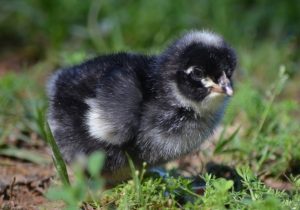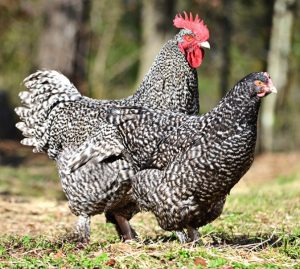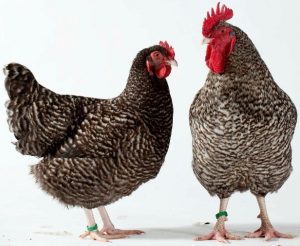Malines Overview
An ancient heavy bird, showing heritage breeding strains of the Bruges Game Bird in its large frame size. This Belgian breed originates from Mechelen, in the Antwerp area of Flanders, with utility properties, producing good eating meat and are reasonable layers of tinted eggs.
Mechelen is halfway between Brussels and Antwerp and often has cold, snowy and wet winters. The males often reach 12 pounds (5.4 kg) or more and females 9 pounds (4 kg). Available in White, Black, Cuckoo, Blue and Ermines (Sussex / l Brahma patterning).
They were originally of Asiatic descent, as shown in that they come both as single combed and as turkey headed bird. The most popular color is cuckoo, as birds of this color are considered to be of the best quality. The feathers are quite thick and downy, continuing down the birds’ legs and toes, providing good insulation against cold weather.
In Holland The Malines is known as the ‘Mechelse Koekoek’
Malines Chickens are large, gentle birds with quite small wings carried close to the body. The tail is quite short and carried almost horizontal to the body. Male tail feathers are easily damaged by birds squeezing through small gaps, thus door openings to runs and cages need to be wide to avoid feather loss. Malines don’t like flying and rarely run off, so low fencing of 4 feet (1.3 metres) is usually adequate to contain the flock. These large birds are highly valued for their meat and fairly consistent egg laying ability, capable of producing up to 160 large eggs a year.
Despite their docile manner, Malines like to stretch their legs and thrive as free-range foraging chickens, but can also do well in more confined conditions.
Malines prefer being outside foraging and will happily stay out for the whole day, from dawn to dusk, enjoying a diet of fallen fruit, insects, weeds and grubs.
Eggs
Size
Malines eggs are usually large, weighing around 2.2 ounces (65 gms). Egg production is between 140 to 160 eggs per year.
Color
Eggs are light brown or cream color
When do they start laying eggs?
Chicks mature slowly and hens start laying from 6 months onwards.

Malines Characteristics
Temperament – Are they good as pets?
Malines chickens are calm and docile if raised by hand and are the ideal chicken breed for first-time backyard farmers. Malines are hardy birds and can tolerate cold temperatures for a few weeks each year, but love to ‘sunbathe’ in the summer. For a large size bird, they have small beaks. Malines are noted for their confident manner and despite their size when fully grown, can make excellent pets. As with all chickens, they do not enjoy being pulled or prodded by children, so careful supervision is required.
Malines chickens will quickly become used to humans if raised by hand as chicks.
One cockerel for around 5 hens is a good ratio.
Malines love to actively forage outside ‘far and wide’ in warmer months and require large spaces for this. These are hardy, disease resistant chickens and considered fairly ‘low maintenance’.
How do I tame Maline chickens?
The best way to tame a chicken is to handle it gently when it is still young; this gets your chickens used to people. If you have older chickens that need taming, try feeding them out of your hand regularly. Malines chickens are noted for their easy-going temperament and gentle nature.
A good idea to train them to regularly return to the chicken coop each night, is to feed them before dusk regularly.
How many do I need to buy?
2 chickens are the absolute minimum you need for a flock, we recommend around 5 as a small flock number.
How much space do they need?
Malines ideally require a large, secure backyard to do well, but smaller backyards can accommodate a small flock. Standard birds are large size and can be confined in small chicken coops for short periods. Ideally 4 square feet minimum per mature bird in a coop and around 20 square feet minimum per bird in a run. Malines Chickens love being outside exploring and foraging for food, so must have good outside access to prevent boredom. These chickens are very poor fliers, so high -level containment fencing is not essential, but protection from predators is required.
Will they mix with my other chickens?
Despite their impressive large bodies, Malines are not aggressive birds, they are very easy going and will get along well with other breeds of chickens. Some backyard chicken keepers have a few Malines solely for their striking looks and calm manner. It is vital the flock is not too closely confined and there is adequate room to explore outside and prevent boredom.
Appearance
The Malines is a large bird with a broad, heavy head and eyes ranging from red to orange. The beak is white and rather small for such a large bird. The comb and wattle are bright red with between four and six serrations on the comb. Thighs and legs are quite muscular to support this large framed bird.
Plumage cover is good over the whole body, but not excessively full. No white skin is visible and the birds have reasonable cold weather insulation. as long as they have rose combs. Feet color can range from yellow, light brown to off-white and eyes are red. Occasionally rare yellow skinned chicks occur, but the breed standard is white skin.

Feeding
What should I feed them?
When you first get your chickens home you should feed them growers mash, as it has a higher percentage of protein (19%) and is refined so that it can be easily ingested. You should feed them growers mash up until 6 weeks where they should be fed chicken pellets which is just feed in pellet form, this has between 15-16% protein. At 22 weeks your chickens need more nutrients to help with egg production so slowly start feeding them layers mash or pellets which has around 16% protein.
Chickens will need access to fresh drinking water all day long, they will prefer cool drinking water, no one is quite sure why maybe it’s a prehistoric throwback. It is important to have the feed and water at the proper height for all birds in the pen. Ideally feed and water should be at back level. If the water is too low down, chickens may scratch litter into it and the water will go bad quickly. Your chickens also need grit to help with egg production. So make sure there is always some within easy access for them at all times. Malines are excellent foragers and will supplement their feed intake by hunting outside for insects, slugs, snails, seeds and bugs to eat.
How much should I feed them?
Malines are large birds, but young chicks should not be overfed to try and accelerate growth, as damage to their bone structure will occur. Fully grown they eat anywhere between 6 oz (170g) and 7 oz (198g) a day. On average breeders feed their chickens 6 oz (170g) a day, depending on the size of the birds and whether they are outside foraging. Start by feeding them this and then adjust the weight of feed around how much they consume. You can leave the feed in a feeder for them to eat whenever they please or you can give them set meal times.
Your chickens also need grit to help with egg production. So make sure there is always some in easy reach for them at all times.
What can’t they eat?
Chocolate and beans are the two main foods that shouldn’t be eaten by chickens. The phytohemagglutinin in beans can lead to fatalities and the theobromine in chocolate can cause heart problems. Moldy food that has bad bacteria in it should not be fed to chickens as it can make them very unwell. For this reason, it is illegal to feed your chickens leftovers in the UK.
For an more indepth read on feeding chicks and chickens jump over to our chickens feeds page for the 101.
What do I need to keep chickens?
The most essential item you need to keep chickens is a coop, which should ideally be 0.5 m2 or 5.2 square feet per chicken. Their run needs 20 square feet (1.9 m2) per chicken. In the coop they should have a perch to sleep on and a wooden laying box for their eggs.
You should invest in a sunken fence to go over and around the coop to keep them safe at night. Find a water bowl which they can’t stand in or push over and place it in the shade, so the water doesn’t get too warm. Feed and water for Malines are best placed off the ground, at around the ‘back’ height of the bird. Raised feed and water bowl holders are easily obtained.


